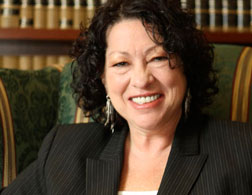What do Nick Jonas and Sonia Sotomayor Share?
 What do Nick Jonas and Justice Sonia Sotomayor have in common? They both have type I diabetes.
What do Nick Jonas and Justice Sonia Sotomayor have in common? They both have type I diabetes.
Nick, age 16, the youngest of the teen singing sensations, the Jonas Brothers was diagnosed at age 13 with type I Diabetes. He currently uses an insulin pump to help him manage his diabetes. He has recently been seen on commercials for Bayer Contour Meter, a portable device for checking blood sugar levels.
This week, Judge Sonia Sotomayor was sworn in as the first Hispanic Supreme Court Justice. She is also the first type I diabetic on the high court, being diagnosed with the disease at the age of 8. Rudy Aragon, a Yale University Law School classmate of Sotomayor, reports that she was “religious about monitoring her blood sugar levels. It’s been an issue with her, but she’s overcome that. She overcomes it every day.” Bill Ahearn, VP of Juvenile Diabetes Research Foundation International, beams: “It’s a great educational moment for people in general. They can see that people that have type 1 diabetes have just as great a chance of success as anyone else.”
What is Diabetes?
Diabetes is a chronic disease where the body is either unable to make, or is resistant to a insulin. Insulin is a hormone that is used to break down and store energy (in the form of glucose or “sugar”) from foods. Without insulin, blood glucose and fat levels become too high and, over time, can damage blood vessels and vital organs.
What is the difference between Type 1 and Type 2 diabetes?
Type 1 diabetes, which used to be called insulin-dependent or juvenile diabetes, is a disease where the body is unable to make insulin. Scientists do not know exactly what causes type 1 diabetes, but they believe that a combination of genetic and environmental factors are to blame. Diabetes is an autoimmune disease. This meansthat the immune system, which normally ignores healthy cells but destroys germs and foreign substances that could cause illness,mistakenly launches an attack on the body itself. In diabetes, insulin producing cells, called islet cells, in the pancreas are destroyed. People may develop type 1 diabetes at any age, but it is frequently diagnosed before adulthood. It accounts for about 5%-10% of all diabetescases, and affects approximately one in every 400 to 500 children in the U.S. Type I diabetes must receive injections of insulin every day to control their disease.
Type 2 diabetes, which was previously called non-insulin-dependent diabetes mellitus (NIDDM) or adult-onset diabetes, may account for about 90% to 95% of all diagnosed cases of diabetes. In this form of the disease, insulin is still made (although possibly at lower levels), but the tissues have become resistant to the effects, leading to a rise in blood sugar. It usually occurs in people who are over 40, overweight, and have afamily history of the disease although it is also becoming more common in younger people, particularly adolescents. Research indicates that type 2 diabetes is caused by a combination of environmental and genetic factors. Many risk factors make people more likely to develop the disease including obesity,high cholesterol, high blood pressure and physical inactivity. Type2 diabetes is more common among Native Americans, African Americans, Latinos and Asian Americans/Pacific Islanders. Diet, exercise, weight loss, and oral medications to lower blood sugar are used to treat Type 2 diabetes.
What are the symptoms of Diabetes?
- Frequent urination
- Excessive thirst
- Unexplained weight loss
- Extreme hunger
- Sudden vision changes
- Tingling or numbness in hands or feet
- Feeling very tired much of the time
- Very dry skin
- Sores that are slow to heal
- More infections than usual
Since diabetes is a big topic, and there are many other celebrities who have the disease, today’s blog is just a short introduction to the subject, and future blogs will deal with other aspects of the disease.
For more information:
![]()

